In which of the sensori - Study guides, Class notes & Summaries
Looking for the best study guides, study notes and summaries about In which of the sensori? On this page you'll find 41 study documents about In which of the sensori.
Page 4 out of 41 results
Sort by
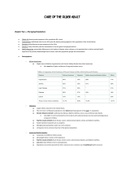
-
C475_ CARE OF THE OLDER ADULT | CHAPTEER 2 - The Aging Population | (Gerontology, AGING, Senescence) | Complete Study Guide
- Other • 10 pages • 2021
-
- $10.99
- + learn more
Chapter Two ― The Aging Population: ● Oldest old: fastest growing segment of the population (85+ years). ● Centenarians: individuals who are over 100 years old; fastest growing segment of the population of the United States. ● Genomics: identification of gene sequences in the DNA. ● Genetics: study of heredity and the transmission of certain genes through generations. ● Health disparities: preventable differences in the burden of disease, injury, violence, or in opportunities to achi...

-
NUR 6435 SB STUDY GUIDE
- Exam (elaborations) • 28 pages • 2021
-
- $17.39
- + learn more
NUR 6435 SB STUDY GUIDE 1. A congenital heart abnormality often discovered during the newborn period is coarctation of the aorta. How is this assessed? By comparing right and left femoral pulses By comparing right and left pedal pulses By comparing upper and lower extremity blood pressures By auscultating an audible bruit in the carotid arteries 2. A child who can stack a maximum of 5 blocks is probably: 1 yr of age 15 months of age 2 years of age 3 years of age 3. A 6 yr old chi...
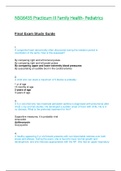
-
NSG 6435 FINAL EXAM STUDY GUIDE 3
- Exam (elaborations) • 43 pages • 2021
-
- $8.33
- + learn more
NSG6435 Practicum III Family Health - Pediatrics Final Exam Study Guide 1. A congenital heart abnormality often discovered during the newborn period is coarctation of the aorta. How is this assessed? By comparing right and left femoral pulses By comparing right and left pedal pulses By comparing upper and lower extremity blood pressures By auscultating an audible bruit in the carotid arteries 2. A child who can stack a maximum of 5 blocks is probably: 1 yr of age 1...
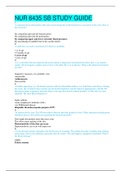
-
NUR 6435 SB STUDY GUIDE | LATEST VERSION
- Exam (elaborations) • 28 pages • 2021
-
- $12.49
- + learn more
NUR 6435 SB STUDY GUIDE 1. A congenital heart abnormality often discovered during the newborn period is coarctation of the aorta. How is this assessed? By comparing right and left femoral pulses By comparing right and left pedal pulses By comparing upper and lower extremity blood pressures By auscultating an audible bruit in the carotid arteries 2. A child who can stack a maximum of 5 blocks is probably: 1 yr of age 15 months of age 2 years of age 3 years of age 3. A 6 yr old chi...

-
NSG 6435 Final Exam Study Guide 3 (COMPREHENSIVE)
- Exam (elaborations) • 28 pages • 2021
-
- $15.49
- + learn more
1. A congenital heart abnormality often discovered during the newborn period is coarctation of the aorta. How is this assessed? 2. A child who can stack a maximum of 5 blocks is probably: 3. A 6 yr old child who has moderate persistent asthma is diagnosed with pneumonia after chest x-ray and lab studies. He developed a sudden onset of fever with chills. He is in no distress. What is the preferred treatment for him? 4.A healthy appearing 3-yr old female presents with non-blanchable redne...
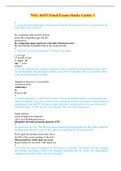
-
NSG 6435 Final Exam Study Guide 3 (VERIFIED)
- Exam (elaborations) • 36 pages • 2021
-
- $20.39
- + learn more
1. A congenital heart abnormality often discovered during the newborn period is coarctation of the aorta. How is this assessed? 2. A child who can stack a maximum of 5 blocks is probably: 3. A 6 yr old child who has moderate persistent asthma is diagnosed with pneumonia after chest x-ray and lab studies. He developed a sudden onset of fever with chills. He is in no distress. What is the preferred treatment for him? 4.A healthy appearing 3-yr old female presents with non-blanchable redne...

-
NSG 6435 FINAL EXAM STUDY GUIDE QUESTIONS AND ANSWERS ATTEMPT 80% GRADE SCORE
- Exam (elaborations) • 28 pages • 2021
-
- $17.49
- + learn more
NSG 6435 Final Exam Study Guide 3 NSG 6435 Final Exam Study Guide 1. A congenital heart abnormality often discovered during the newborn period is coarctation of the aorta. How is this assessed? 2. A child who can stack a maximum of 5 blocks is probably: 3. A 6 yr old child who has moderate persistent asthma is diagnosed with pneumonia after chest x-ray and lab studies. He developed a sudden onset of fever with chills. He is in no distress. What is the preferred treatment for him? 4....
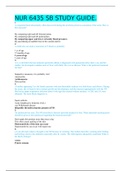
-
NUR 6435 SB STUDY GUIDE (UPDATE)
- Summary • 29 pages • 2021
-
- $13.49
- + learn more
NUR 6435 SB STUDY GUIDE. 1. A congenital heart abnormality often discovered during the newborn period is coarctation of the aorta. How is this assessed? By comparing right and left femoral pulses By comparing right and left pedal pulses By comparing upper and lower extremity blood pressures By auscultating an audible bruit in the carotid arteries 2. A child who can stack a maximum of 5 blocks is probably: 1 yr of age 15 months of age 2 years of age 3 years of age 3. A 6 yr old ch...
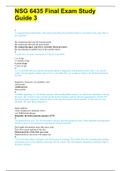
-
NSG 6435 Final Exam Study Guide 3 | LATEST SOLUTION
- Exam (elaborations) • 32 pages • 2021
-
- $18.49
- + learn more
NSG 6435 Final Exam Study Guide 3 NSG 6435 Final Exam Study Guide 1. A congenital heart abnormality often discovered during the newborn period is coarctation of the aorta. How is this assessed? 2. A child who can stack a maximum of 5 blocks is probably: 3. A 6 yr old child who has moderate persistent asthma is diagnosed with pneumonia after chest x-ray and lab studies. He developed a sudden onset of fever with chills. He is in no distress. What is the preferred treatment for him? 4....
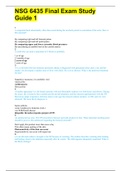
-
NSG 6435 Final Exam Study Guide 1 | GRADED A
- Exam (elaborations) • 31 pages • 2021
-
- $18.49
- + learn more
NSG 6435 Final Exam Study Guide 1 NSG 6435 Final Exam Study Guide 1 1. A congenital heart abnormality often discovered during the newborn period is coarctation of the aorta. How is this assessed? 2. A child who can stack a maximum of 5 blocks is probably: 3. A 6 yr old child who has moderate persistent asthma is diagnosed with pneumonia after chest x-ray and lab studies. He developed a sudden onset of fever with chills. He is in no distress. What is the preferred treatment for him? ...

Did you know that on average a seller on Stuvia earns $82 per month selling study resources? Hmm, hint, hint. Discover all about earning on Stuvia


